When I was a little kid impatiently awaiting Santa’s arrival, I didn’t fully appreciate what my parents were doing by foregoing traditional wrapping paper for eco-friendly gift wrap.
It wasn’t until I got a little older and the holiday season grew to encompass more important things than gifts that I realized just how much wrapping paper we’d go through in one year, and what my parents were trying to do by not adding to that pile. Just thinking about the trash accumulated on that one morning in our household let alone our neighborhood, our city, and the rest of the world is an eye-popping amount of waste. In fact, it’s estimated that Americans alone throw out an additional 25 million tons of garbage during the holidays!
Now I know my parents were on to something with their recycled wrapping (not to mention the fact that it could then itself be recycled), and it’s a tradition I continue today. So before you buy another roll of glossy wrapping paper, check out these eight ideas for sustainable gift wrap this holiday season.

Physical newspapers aren’t as commonly delivered as they used to be, but that doesn’t mean you can’t use other recyclable paper or packaging to disguise your gifts. Magazines, cardboard boxes, and other delivery items can all be repurposed for your wrapping and decorating needs.
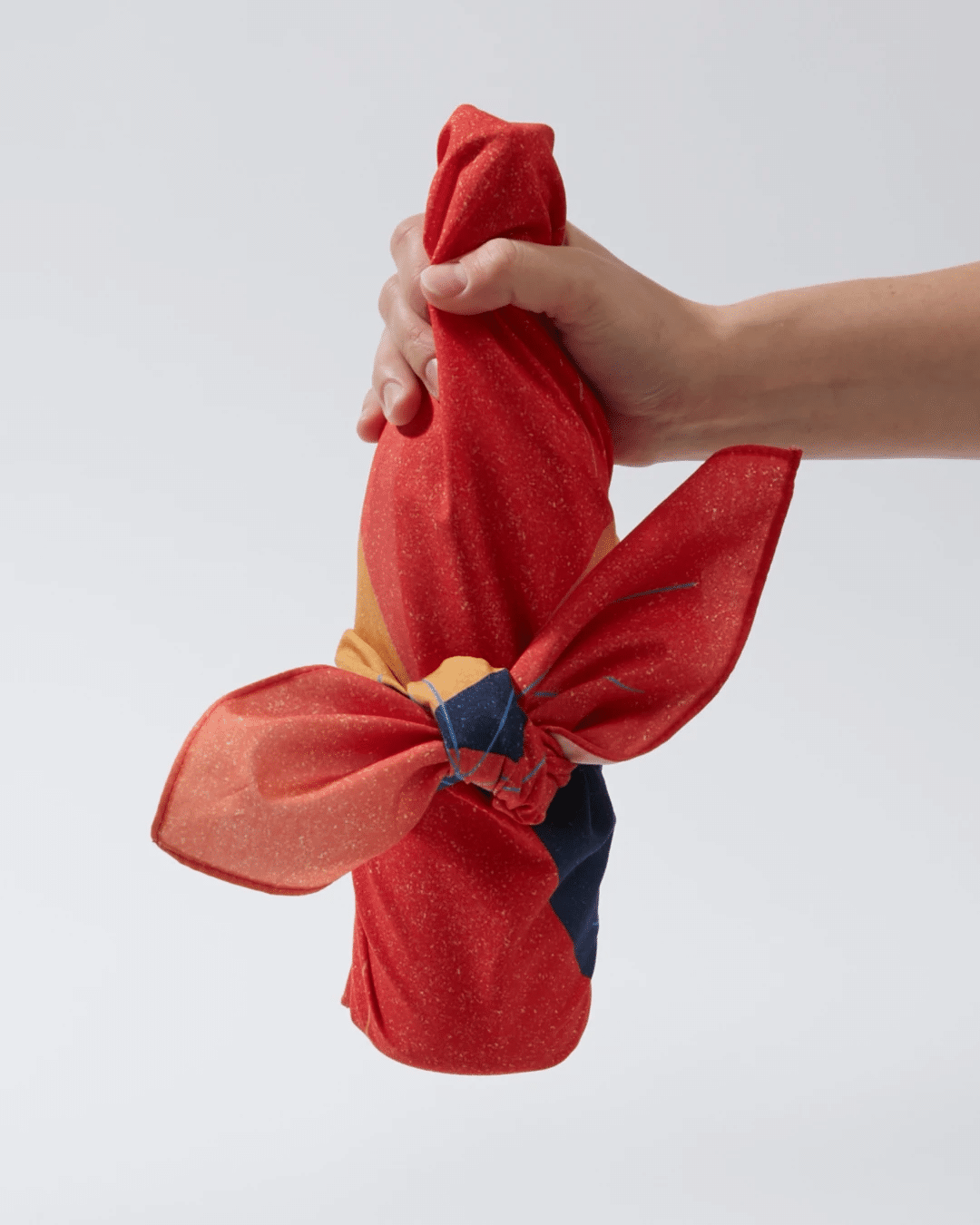
Wrappr’s motto is “give art, not waste.” Inspired by a trip to Japan and a deluge of gifts in celebration of their new baby, the co-founders of Wrappr now make reusable furoshiki wraps for gifts. They can be used to wrap a wine bottle, jewelry, or any small gift box. Be careful, though, because the wrapping has the potential to be more elegant than what it’s covering!
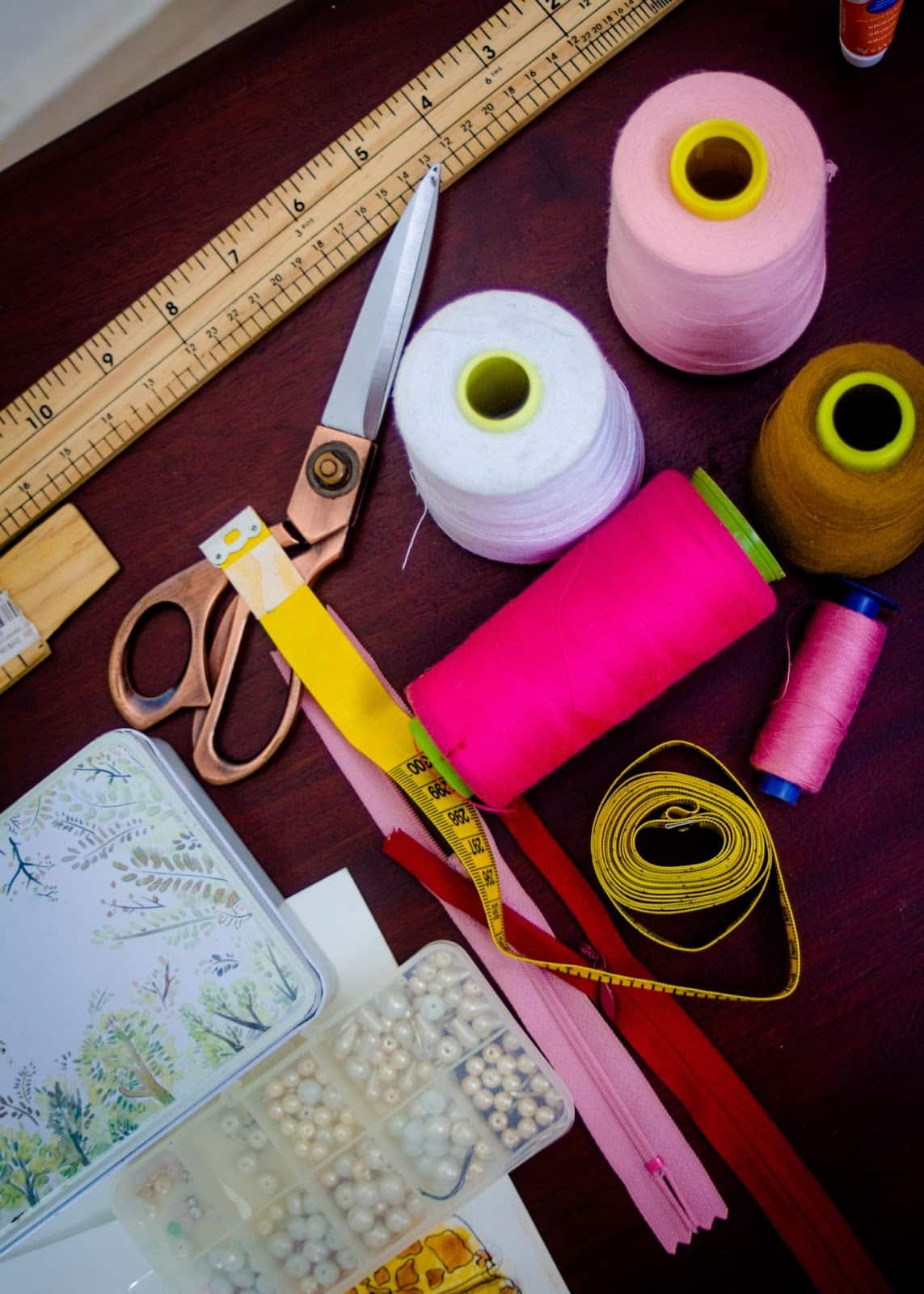
Have a beloved t-shirt that doesn’t fit anymore? Turn it into reusable gift wrap! If you’re handy with a sewing machine, combine a few squares of fabric to make your own totally unique wrapping. Then make sure the recipient knows to pay it forward next year.
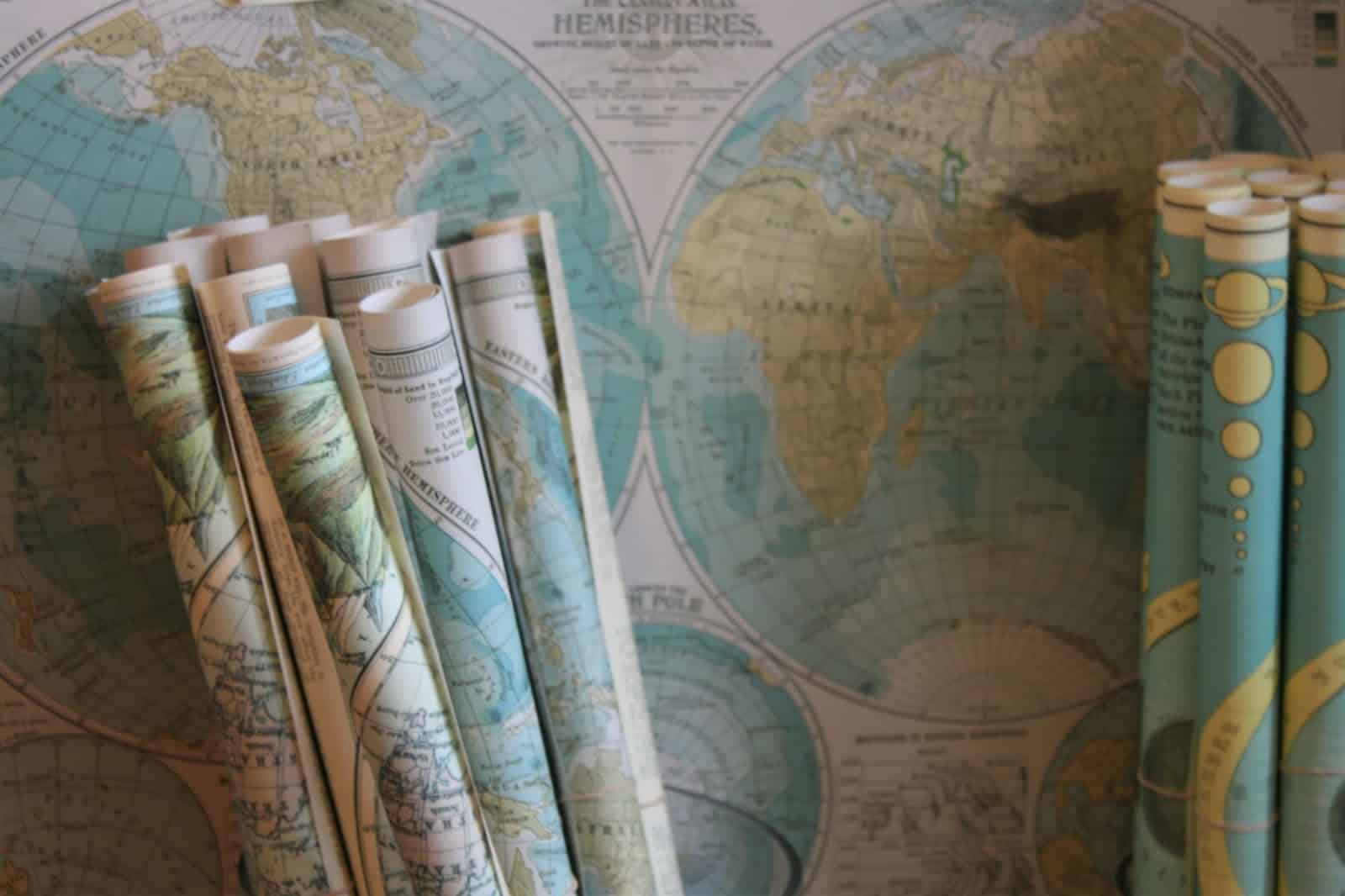
When’s the last time you used a physical map to get from point A to point B? Check your glove box or your bookshelf for old maps to wrap up your gifts with. This is perfect for the person on your list with wanderlust.

You’re already doing the right thing by choosing paper over plastic. Now upcycle those bags into eco-friendly gift wrap this holiday season. Whether you use the bags in their original shape with some recyclable paper on top or break them down into strips of paper for wrapping, this is another great option that can be recycled after the gift is unwrapped. If you’re feeling really festive, turn the bags inside out and decorate the blank side with a holiday motif.
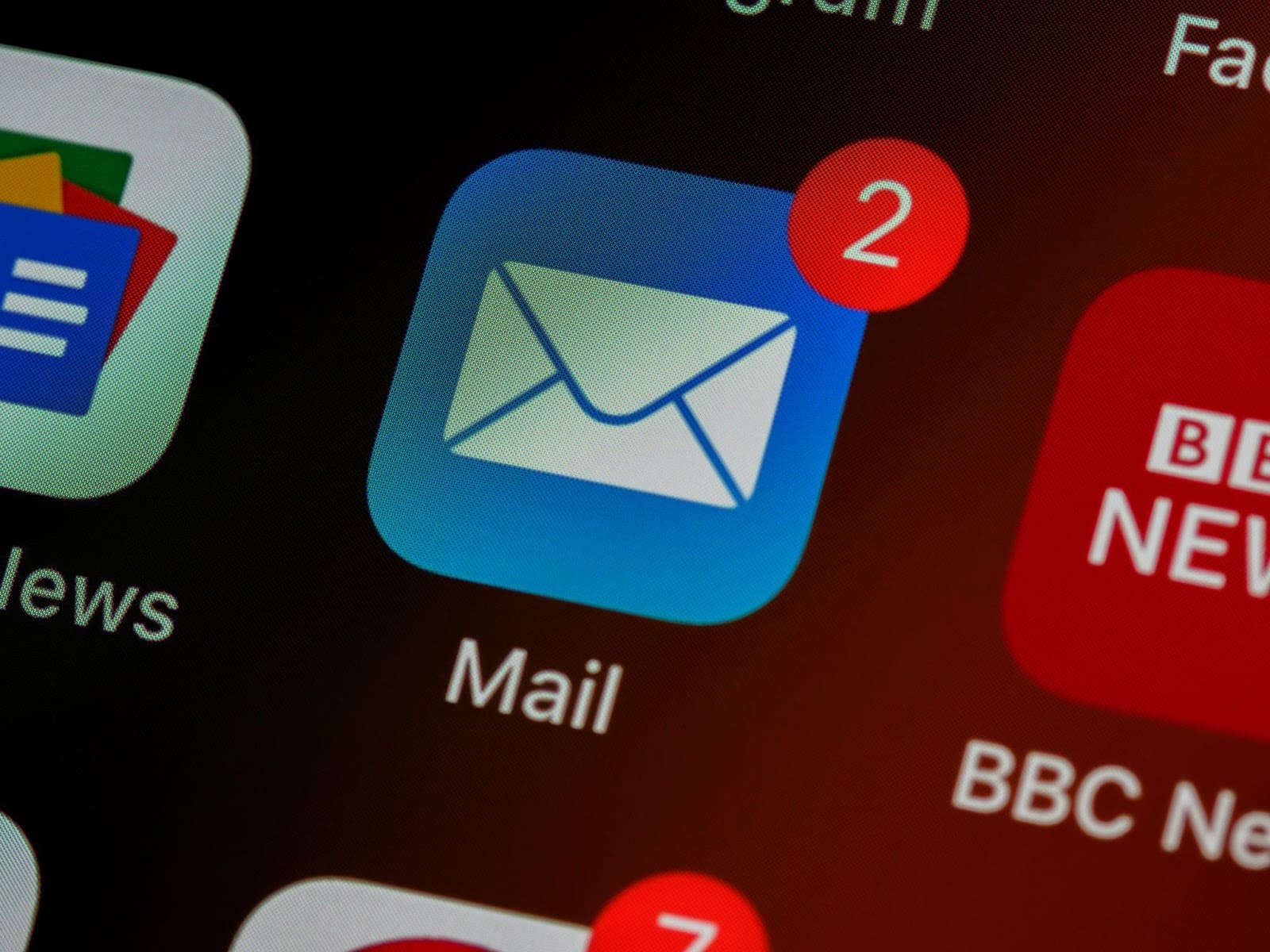
The best way to use eco-friendly gift wrap is not to use any gift wrap at all. Rather than a material gift or gift card, see if your favorite retailers offer digital delivery or experiences with a low environmental impact. Double down by gifting donations to sustainability-focused groups and then emailing your recipients the green news!

Instead of adding more waste like ribbons and bows to your wrapping, take a walk outside and collect some seasonally-appropriate flourishes. Pinecones, small tree branches, cotton buds, and flowers all make for festive toppers.
Want to jingle all the way with your holiday gift topper? Cut a few sprigs off your tree or stop by a Christmas tree sale and collect some of the extra branches that dot the lot.

Of course, you can’t wrap most gifts without using tape! If you want to be even more environmentally friendly this holiday season, try using gummed paper tape for all your gift-wrapping needs.
The company Life Without Plastic offers water-activated kraft tape that is 100% recyclable and compostable. Each roll can also withstand harsh weather conditions such as high heat, humidity, and frigid temperatures.
Read more about their commitment to the environment here.
We hope these ideas help make your holiday a little more sustainable, and we wish everyone a very happy holiday season no matter how you celebrate!
If you’re last-minute shoppers like us and need a few sustainable gift ideas to go along with the eco-friendly gift wrap, look no further than our sustainable gift guide.
What are you going to use to wrap your gifts this year? We’d love to see photos of your sustainable gift wrap, holiday decorations, and gifts on Facebook, Instagram, Twitter, or LinkedIn!
November 15th is National Recycling Day, and unlike National Chocolate Covered Cashews Day or International Talk Like a Pirate Day, it’s one that we proudly recognize and celebrate at Bevi HQ (not that we’d discourage you from going nuts on NCCC Day if that’s your jam).
As an organization that’s helped offices all over the country save the equivalent of 200 million plastic bottles, we have no shortage of reasons to promote this holiday. It’s a day aimed to encourage Americans to purchase recycled products when possible and to be more conscientious about what they’re doing with recyclable materials once they’re through with them—to reduce, reuse, and recycle if you will—and that’s at the core of what Bevi was created to help do.
As we’ve cited before, over 50 billion plastic water bottles are sold each year, and each bottle takes more than 400 years to biodegrade. Even worse, the amount of plastic waste dumped into our oceans is estimated to exceed 8 million tons each year. Every office that makes the pledge to cut down on plastic with a sustainable water dispenser and properly recycle the materials they do use helps to stem the tide.
The triangular recycling symbol is iconic. It’s our go-to guide for deciding what’s recyclable and what’s not. Did you know, though, that according to The New York Times, “any product can display the sign, even if it isn’t recyclable?” The good news is that California is leading the charge on changing this, and similar legislation in Oregon, Maine, and New York is underway. The California law would “ban companies from using the arrows symbol unless they can prove the material is in fact recycled in most California communities, and is used to make new products.”
Even without deception, there are plenty of reasons that we don’t recycle as much as we should. It’s not as convenient as the trash cans that are on every corner. When it is convenient, the rules about what we can recycle are still opaque. And even if it makes one person feel good about their habits, how much difference can they make in the grand scheme of things?
While it may not seem like one person can recycle a consequential amount, getting your neighbors or your coworkers involved definitely adds up. With Bevi, for example, one office can save about 30,000 bottles a year. Here are some other ways you can improve recycling and avoid mistakes at your office.
We’ve previously compiled a more comprehensive list of tips for better recycling at work, but today’s a good day to share some of the most effective ones.
Guidelines will vary from region to region so get familiar with what’s accepted curbside near you and what office supplies might require disposal at a special facility (e.g. light bulbs or e-waste like computers and smartphones).
Generally, the higher the number inside the recycling symbol on a plastic bottle, the less likely it is to be accepted at your recycling center. Numbers 1 and 2 are most common and usually safe to put in your curbside recycling, but anything higher should be double-checked.
Before you add anything new to your office, take a moment to think about its environmental impact. If you can, shop for sustainable office supplies. Washable cloth towels in place of paper towels, for example, is a great place to start.
We also find that a little positive reinforcement goes a long way in our office. Something as simple as placing a recycling bin next to every trash can or keeping a list or photo of commonly recycled items in the kitchen area can help employees make the decision to sort and recycle instead of the easier option of trashing.
Unsure if something should be recycled? Consult a resource like earth911.com to get more information on the item in question, and make sure you’re not “wish-cycling” something just because you’re hoping it can be recycled.
While the majority of these “national” days are just for fun, National Recycling Day is one we really care about. We’re on a mission to unbottle the future, and we’re planning to take that mission as far as possible one office at a time. We hope our recycling reminders inspire you to check up on the ways you can improve the recycling program at your own office, and if we can be of any help to get you and your coworkers into the sustainable spirit, let us know!
As always, join the conversation on Facebook, Instagram, Twitter, or LinkedIn so we can see what you’re doing to celebrate National Recycling Day!
Over 50 billion plastic water bottles are sold each year, and each bottle takes more than 400 years to biodegrade. Would it be great to eliminate non-recyclable plastic entirely? Absolutely. Is it realistic? No, it really isn’t.
Does that mean we shouldn’t be conscientious and intentional about recycling what we can? Of course not. We all know we should be doing it. We all already get most of the obvious bottles and cans in the right bin. And yet, we all have a little room for improvement.
With a little more attention and care, you can master the plastics number system for your area, get your recycling clean, empty, and dry, and help your whole office with common recycling questions. With plastic production expected to triple by 2050, efforts to improve recycling habits are important to implement today.
Before we talk about improving our recycling habits, let’s make sure we’re on the same page regarding the basics and what’s even eligible for collection. The major recyclable categories are bottles, cans, paper, and cardboard. These shapes and formats are generally safe for recycling, though it’s important to check with your local municipality about what they do and do not accept in each category. For example, even if they have what appears to be the chasing arrows symbol on them, not all plastics are eligible for recycling.
According to Waste Management, there are three general rules to remember when asking yourself some common recycling questions:
We all hesitate when choosing between the recycling or trash bin for an oddly-shaped bottle or a slightly greasy pizza box. Make it easy to recycle in your workplace by posting this printable guide near the bins in your office.
First and foremost, make it easy. Anywhere you have a trash can, add a recycling bin. If it’s just as easy to recycle something as it is to throw it away, there will be no excuse not to make the right choice.
Pay attention to the numbers on the plastic items you’re considering recycling. Generally, the higher the number, the less recyclable it is. For example, 1 and 2 are the most commonly recycled (soda bottles, detergent containers, etc.). Though other numbers are less widely accepted, that doesn’t mean that your curbside pickup won’t take some of them. For more information on what kind of plastic each number corresponds to, check out this guide from Good Housekeeping.
For office-specific items like e-waste that require special drop off, upcycle a cardboard box to collect them and then schedule pickups or take turns bringing them to the appropriate locations. Like we do with the bottle counter on Bevi filtered water dispensers, keep track of these specialty items that are diverted from the landfill and provide an occasional update with positive reinforcement.
Beware of flexible packaging like chip bags, lined coffee cups, and juice pouches. These are often made of multiple materials which make them ineligible for recycling. Conversely, something like an envelope or a pasta box with a plastic window can be recycled.
Don’t worry if something isn’t spotless. While recyclables should be dry and as free of food waste as possible, this shouldn’t be as cumbersome as actually doing the dishes. The main thing is to do your best to get anything out that might contaminate other recyclables.
At the end of the day, don’t take a shot on something just because you hope it’s recyclable. Recycling advocates call this “wish-cycling,” and as mentioned earlier, non-recyclable items can contaminate recyclable products, add increased costs to sorting centers, and even break recycling machinery. Have something you think should be recyclable but aren’t sure if it should go curbside? Consult a resource like Earth911.org to find out where and how it can be recycled.
While it will take more than your office recycling program to truly make a difference in the battle against plastic, there are plenty of ways to improve your personal recycling habits and contribute to the solution in the meantime.
We take the long view at Bevi, and we know that although one office space may not seem like it’s making a huge impact by itself, added all together, Bevi customers have saved over 200 million bottles to date. Let’s all do our part and continue to stay the course of sustainable practices in the office and wherever else we can.
How are you answering common recycling questions and encouraging better recycling at your workplace? We’d love to hear your ideas on Facebook, Instagram, Twitter, or LinkedIn!
Spoiler alert: it’s no contest! But we’re not just talking about the natural flavors and ease of use. Bevi isn’t just a product; it’s a mission to unbottle the future, and we’re proud to share that we’re doing just that.
By connecting our sustainable water dispensers directly to existing water lines, we’re able to cut out plastic, save energy, and keep precious resources in the ground while keeping toxic byproducts out of the atmosphere.
But we’re not doing this alone. To date, Bevi customers have saved over 230 million plastic bottles. To give you an idea of just how huge that number is, if you stacked all of the plastic bottles our customers save each year, end-to-end, it would be as long as nearly 10 trips cross country from Boston to San Francisco!
With numbers like that, it’s obvious to us why Bevi water coolers are definitely a smarter way to hydrate than bottles, but read on for some more data to back up our case, and start imagining where you’ll be putting your new smart water dispenser!
Globally, more than a million plastic bottles are sold every minute. While most are theoretically recyclable, only about 30% actually end up being repurposed in some form. The bottles that end up in a landfill? Those can take 450 years to biodegrade. If they don’t make it to the landfill, there’s a good chance they’re polluting our waterways. The amount of plastic waste dumped into our oceans is estimated to exceed 8 million tons each year.
And it’s not just that these bottles stick around for a long time once they’re produced. The actual production is just as environmentally costly. Making a 16-ounce bottle of water takes 1.4 gallons of water and enough oil to fill a quarter of that bottle. Then, getting that bottle from the factory to your fridge releases 62 grams of carbon dioxide into the air. All in all, the annual carbon footprint of bottled water is equal to that of 5 million cars.
While they may seem convenient at the time you reach for them, bottled water’s hidden cost is unsustainable. That’s why we started Bevi and why each and every sustainable water dispenser that we’re able to place in a new office is a win for everyone and our environment.
The obvious difference between Bevi’s bottleless water dispenser and the common bottle of water is the lack of plastic. As previously mentioned, the low rate of recycling, the resources needed to make it, and the lengthy amount of time for it to biodegrade all make getting rid of plastic bottles in offices and other commercial spaces a no-brainer.
To that end, just one Bevi bottleless water cooler can save over 30,000 bottles and cans in a year. Multiply that by the oil that stays in the ground, the carbon dioxide that isn’t released into the atmosphere, and the energy that doesn’t leave the grid, and you can see how much more sustainable a water dispenser is than plastic bottles.
But the benefits of a bottleless water cooler go much farther. Our eco-friendly solutions are sustainable in every way. For example, one Bevi flavor package yields up to 400 12 oz. drinks using the same amount of plastic as just 2 bottles. The boxes that house our flavor bags are made from 100% renewable and recyclable corrugated fibers. Our CO2 tanks are refillable and reusable. Most importantly, we get our water straight from the tap, using 2,000 times less energy than it takes to produce a bottle of water.
We like to think of our water dispensers as not only more sustainable but also a smarter way to hydrate. In addition to being better for the planet, your employees can make custom drinks using natural extracts and no artificial ingredients, enjoy flavors with caffeine and electrolytes for an extra boost, and rally around the real-time counter that shows how many bottles your office is saving.
We know what you’re thinking—that’s a lot of good news. Bevi beats bottles in a landslide. There must be a catch. But there really isn’t. Even if we’re just comparing the bottom line, you might think a sustainable water source would cost more. On average, with Bevi, one 12 ounce beverage costs between $0.12 – $0.28. The average 16.9-ounce bottle of water? More than twice that!
Curious about the other benefits of having a sustainable water dispenser at your office? Get in touch here, and if you liked this article, we’d love to hear from you on Facebook, Instagram, Twitter, or LinkedIn!
One of the silver linings of remote work was the noticeable impact it had on the environment. Fewer daily commuters, minimal business trips, and lights turned off at empty office buildings all added up in a positive way. Even as it turned into a meme format, it became clear that nature was indeed healing.
As we return to working in-person and implement changes for hybrid office spaces that support the future of this work, we’re looking for inspiration from offices that have been leading the charge to facilitate these kinds of environments. We’re not only looking for fun places to work, but also at how well they’ve combined sustainability with innovation. In our view, the best offices and the coolest offices are often the most sustainable as well. Here are some of the offices that we can’t wait to emulate once we’re back at Bevi HQ.

Bloomberg’s European headquarters in London has been dubbed the world’s most sustainable office with a BREEAM rating of 98.5%. In addition to being a zero-landfill facility and using rainwater collected on the roof to create a net-zero flushing system, the building also uses solar panels to help power the building.
What really sticks out to us, though, is the combination of community and design. Project architect Michael Jones said, “The facility was designed to encourage interaction both within the office and the surrounding community.” Reclaiming office spaces for safe interactions is a top priority as we make physical changes to facilitate the needs of hybrid workforces.
Additionally, any fresh design elements that encourage social interaction will help your team sync up and get back to business quickly. For example, the looped ramp walkway pictured above is “designed to encourage conversation while not impeding the flow of people.”
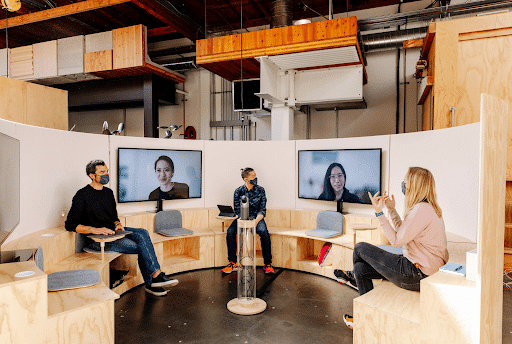
Once the king of office perks, Google is now setting out to be the leader in hybrid office spaces. They’d begun to deal with the growing pains of a globally distributed team before the pandemic, and the move to remote work last year accelerated plans for optimizing this setup.
Instead of the desks and meeting rooms we typically associate with corporate office space, Google is implementing “Team Pods.” “Each pod is a blank canvas: Chairs, desks, whiteboards and storage units on casters can be wheeled into various arrangements, and in some cases rearranged in a matter of hours,” according to the New York Times.

Outside, in what looks like Coachella-glamping-meets-upscale-tailgating, Google is trialing outdoor workspaces for locations with accommodating weather. If your office is on more of a lean-to budget, it can’t hurt to reimagine what outside space you could repurpose or retrofit for meetings in the shade that don’t require an abundance of technology.
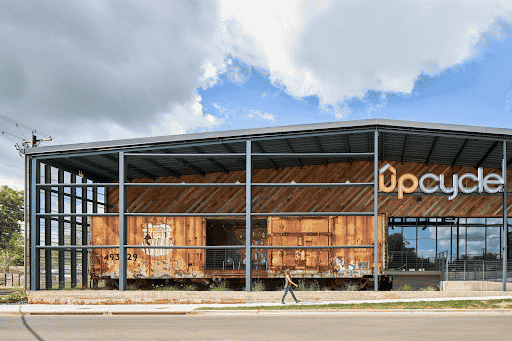
The vision for UPCycle in East Austin was to take a vacant warehouse and create a modern, sustainable office space for multiple tenants. On its face, it sounds like any old WeWork, but the focus on sustainability from the ground up makes it shine in a totally different way.
For starters, according to Gensler, 95% of the existing building, a shipping facility and warehouse, was used in the redesign. Other sustainable design elements include skylights to make use of natural light and a more efficient ventilation system.
As we design our own hybrid spaces for safe collaboration this summer, find inspiration in the roll-up garage doors at the front of the building. They simultaneously increase fresh airflow inside while inviting tenants to step outside on a nice day.

Etsy, headquartered in Brooklyn, made a point to include open collaboration spaces, ample bike parking (65% of employees bike to work during warmer months), and reclaimed wood in their relocation a few years ago.
Spacious indoor collaboration zones and outdoor courtyards, including a garden on the roof, now appear prescient as many hybrid office spaces will seek to incorporate the same in order to allow for distancing between employees.
What makes this one of the coolest offices on the list is that Etsy didn’t forgo fun while designing their new space. Meditation sessions, catered meals, craft nights, and other perks all make the office an inviting space to be from 9-5 or 5-9.
Some companies had a head start on designing cool, sustainable, hybrid office spaces, and some are just starting the planning phase of returning to the office. No matter where you find yourself, take advantage of the ability to rethink your space and generate excitement around getting back to the office and reconnecting with coworkers.
Planning our own return to the office became a lot more fun as we found more and more design inspirations like those above, and we hope you came away with a few fun ideas for your office as well.
If you enjoyed this article, we’d love for you to share it and let us know how your own return is going on Twitter, Facebook, Instagram, or LinkedIn!
It’s no secret that we need to do a better job of protecting our planet. Even with encouraging declarations from countries like New Zealand, which vows to become a carbon-neutral government by 2025, and the United Kingdom, which promises to cut its carbon emissions by 68% by 2030, it isn’t enough to reverse the disastrous impacts of global warming. A new report released by the United Nations suggests that since the signing of the Paris Agreement 5 years ago, the world is far from hitting its climate goals.
However, saving the planet shouldn’t be a chore. No matter how small, every individual’s contribution can collectively make a big change. Have you ever considered the small things you can do in your everyday life to make a difference? Believe it or not, there are tons of simple ways you can help, starting with removing plastic.
The use of everyday plastic in the modern world has become a major catalyst to our environmental problems. Since the early 1950s, researchers estimate that more than 8.3 billion tonnes of plastic have been produced, of which 60% of that plastic has ended up in either a landfill or the natural environment. 8 million tonnes of plastic end up in the world’s oceans every year alone. And if these trends continue? Plastic could account for 20% of the world’s total oil consumption by 2050, according to the United Nations.
Removing plastics from your everyday life and substituting them with more eco-friendly options is one of the simple ways you can help make a big difference. Check out these 5 easy ways to reduce your everyday plastic use:
Skip the plastic water bottles and invest in an aluminum, reusable one. Why? Let’s take a look at the numbers and facts around producing plastic water bottles.
In 2006, it took approximately 17 million barrels of oil to make all the plastic for bottled water consumed by Americans. For context, that was enough energy to power 1 million vehicles for a year. In 2018, Stanford University estimated the oil consumption was 50 million barrels for plastic bottle production. And that’s not all—that doesn’t factor in the fossil fuels used to transport the plastic bottles from the manufacturers to the bottling facility. That reusable water bottle seems a lot more worth it now, doesn’t it?
Buying beverages on your lunch break or grabbing bottles and cans of drinks from the work refrigerator? Say no-more and ask your company to decrease its footprint. Ask them to invest in a better way to hydrate with Bevi, the smart bottleless water dispenser. Bevi’s average machine displaces 30K bottles and cans per year. Plus, for companies that offer bottled and canned beverages, it reduces costs by 40-60%. You’ll score brownie points with the CEO for saving money and the whole office will be giving you high-fives for introducing them to their new favorite guilt-free beverages.
Don’t pay the extra 10 cents per bag they charge you at the grocery store. Save your money and save our planet by bringing some reusable bags when you go food shopping, to the pharmacy, or out for a day shopping with friends. Pro tip: leave them in the trunk of your car so you don’t forget when you go grocery shopping each week. You’ll thank us for that one later!
Next time you are out for drinks or grabbing an iced coffee at your local coffee shop, ask the bartender or the barista to skip the straw. If you rely on straws because of a disability, you can buy a reusable straw made out of stainless steel, bamboo, or even glass to bring with you on-the-go. They even make ones with to-go cases and cleaning brushes so you can stay clean and eco-friendly.
Before you order your takeout, you can avoid using plastic containers in one of two ways. First, call ahead to the restaurant and ask if they would be willing to package your food in compostable packaging i.e. paper, cardboard—package it plastic-free. Ask to skip the plastic cutlery and use your own at home. Most restaurants will be happy to accommodate these requests.
If that is not an option, Kathryn Kellogg, author of the blog and book “Going Zero Waste” suggests bringing your own glass or plastic-free containers. She does this with most of her local take-out favorites and talks about tips for how to best approach it for the first time in her blog.
Your environmental impact has a ripple effect. No matter how small these changes might be, starting by reducing plastics from your everyday life with these 5 easy tips makes a big difference in protecting our planet.
What other tips do you have for removing plastics in your day-to-day life? Re-share this article and let us know your ideas on LinkedIn, Twitter, Instagram, or Facebook!
Every day, approximately 8 million pieces of plastic pollution find their way into our oceans. Many of these are plastic water bottles. But recent research reveals that plastic containers may also be polluting the water inside them in the form of microplastics.
Several studies have looked at the presence of microplastics in a variety of sources, including bottled and tap water. The National Oceanic and Atmospheric Administration (NOAA) defines microplastics as plastic debris less than five millimeters in length, or about the size of a sesame seed.
One study published in the journal Environmental Science & Technology in March 2020 investigated microplastics in table salt, drinking water, and air. With regard to water, the researchers found microplastics present in both tap water and plastic bottled water.
Results from research at the University of Victoria in Canada revealed that people in the U.S. who drink only bottled water might take in as much as 90,000 particles of microplastics in a single year compared with just 4,000 for tap water drinkers.
Dr. Sherri Mason, professor of Chemistry and Sustainability Coordinator at Penn State Behrend, was part of a team looking into the origin of microplastics in bottled water. Among her team’s findings were that most of the microplastic in bottled water was polypropylene, the material used to make bottled water caps. In a Time.com article, Mason said, “This seemed to suggest that it was the act of bottling the water that was contributing most of the plastic.”
The short answer is, “no, at least not now.” Still, there was enough concern generated by many of these studies for the World Health Organization to issue its own report. In it, the WHO states that the current levels of microplastics in drinking water don’t appear to pose a health threat. However, they do acknowledge that this assessment is based on a small volume of research and that more investigation is needed.
While microplastics are getting a lot more attention, they’re really just an extension of a long-existing problem. In 1973, Nathaniel Wyeth patented polyethylene terephthalate (PET) bottles. More than four decades later, that cheaper alternative to glass bottles has become part of a massive dilemma. Plastic bottles consume vast amounts of fossil fuels to produce and transport. And at the end of their single-use lives, seventy percent of them wind up in landfills, incinerators, or littering the land and the ocean.
The discovery of microplastics and the uncertainty around their harmfulness to humans and animals only adds to the unwanted result of plastic proliferation. So maybe the choice is less about bottled or tap water and more about plastic or not.
That idea has driven a number of innovative solutions enabling people to enjoy of water without plastic bottles, such as those from Bevi. As a result, we’ve seen many people enthusiastically embrace the idea that you don’t have to choose between what’s good for you and what’s good for the environment. And together, we’ve saved the world from more than 200 million plastic bottles – and the microplastics that come with them.
If you’d like to join us in our goal to keep both people and our planet healthier, we’d love to talk with you over a glass of water.
In July of 2020, Bevi users reached a notable milestone: They helped save the planet from 200 million plastic bottles. Eliminating the need for plastic bottles and cans is a driving force behind the concept of the Bevi office water dispenser. So much so, that a user can see just how many bottles a particular machine is saving with a counter right in the Bevi touchscreen.
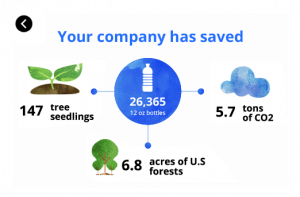
While that may be the most obvious indicator of a positive effect on the environment, there is more behind Bevi’s approach to supporting sustainability in the workplace.
Before you ever grab a beverage at work, a good deal of energy has gone into getting that bottle of water into the office refrigerator. The source for more than half of all bottled water comes from springs and aquifers. Moving all that water to a bottling facility requires energy for pumps and trucks. The bottles it goes into also require significant resources to produce. In a 2007 study, the Pacific Institute found it took the equivalent of approximately 17 million barrels of oil to make all the plastic for bottled water consumed by Americans in 2006. That’s was enough energy to power 1 million vehicles for a year. More recent research at Stanford University in 2018 put the oil consumption number for plastic bottle production at 50 million barrels per year.
But that’s not the only area where fossil fuels come into play. Still more are used in transporting the 50 billion plastic bottles used each year in the U.S. from the manufacturer to the bottling facility.
Finding a better way to do something often requires doing it differently. Point-of-use office water dispensers, such as those from Bevi, connect to an existing water line. From there, the water can be dispensed still, sparkling or flavored right into a glass or reusable beverage tumbler. This not only cuts out the need for plastic bottles and aluminum cans, it eliminates the substantial amount of fuel needed to source, bottle, and transport the water.
While point-of-use water dispensers are certainly more environmentally friendly, there are additional ways to shrink the carbon footprint of your glass of water. By connecting water dispensers to the internet, some manufacturers are able to monitor specific aspects of their machines, such as filter life and supply levels of flavors and CO2. With this information, maintenance and restocking calls can be more accurately scheduled, minimizing the fuel consumption of service vehicles.
In addition to using machine data to schedule flavor and CO2 refills, Bevi has made the service process even greener. Bevi uses flavor boxes made from recyclable materials that can also be easily recycled after use. And the flavor bags, which are made from recyclable #7 plastic, are accepted in some community recycling programs.
There’s nearly universal agreement that staying hydrated throughout the day is important to staying healthy, feeling good, and being more productive. How each of us does that is a personal choice, but we believe a choice that’s good for people as well as the environment is one worth offering. It’s an idea that has caught on with many companies and their employees. You can read about them here. We’re proud to be part of our customers’ efforts to save 200 million plastic bottles and we continue to look for ways to help them stay healthy and be greener.
From a nightclub stage, a comedian riffs about trash and recycling. “With trash, if there’s something you don’t want anymore, you throw it away and you never see it again. But with recycling, you toss it in the bin and it comes back as something else you will eventually have to get rid of all over again.”
While this open-mic-night insight may not be entirely accurate, it does hint at an awkward truth surrounding recycling: Using bottles and cans means always having to deal with them when we’re done.
On average, Americans crack open around 1500 bottles of water each second. That translates to 90,000 every hour and 2.2 million every day. From a human health perspective, it’s good that we’re drinking so much water. However, for the health of our planet, the effects aren’t as beneficial.
While most of those plastic bottles can be recycled, a large percentage of them aren’t. Dr. Peter Gleick, the author of “Bottled and Sold: The Story Behind Our Obsession with Bottled Water,” says only 30 percent of those bottles make it into the recycling bin. The rest wind up in landfills, incinerators, or littering the land and the ocean. In fact, a widely reported study by the World Economic Forum and the Ellen MacArthur Foundation determined that by the year 2050, the ocean will contain more plastic than fish. And many of those fish will have ingested a significant amount of that plastic.
Another thing to consider is putting water in aluminum cans instead of plastic bottles. Take a look inside the fridge in just about any office kitchen, breakroom, or cafeteria and you’ll likely see the most popular waters, seltzers, and flavored beverages in shiny aluminum rows.
Along with being easier to stack and taking up less fridge space, cans have a much higher recycling profile than their polyethylene cousins. Cans in the U.S. are recycled at rate of 50 percent, distinguishing them as the most recycled beverage container in the world. Plus, the high recyclability of aluminum means that 75 percent of all aluminum produced is still in circulation, and each regenerated can uses 90 percent less energy and produces 90 percent less emissions compared to producing a brand new can.
The environmental attractiveness of recycling cans is increasing demand. However, the problem with that is there are not enough cans in circulation right now to meet that demand. More will need to be made from scratch, and creating a new can produces double the greenhouse gases of a plastic bottle. So, while we’re improving sustainability through recycling, we’re working against that by adding carbon through can manufacturing.
Staying properly hydrated and preserving the environment don’t have to be so complicated if you consider an alternative to bottles and cans. Smart beverage dispensers, like those from Bevi, let you get that drink without the plastic or aluminum middleman. They not only supply pure filtered and sparkling water right into your reusable tumbler cup, they let you easily add electrolytes to boost your hydration and flavors to elevate your mood.
At the same time, you could be replacing 30 thousand bottles and cans each year, and as the standup comedian would point out, “never having to deal with them again.” And that may be the most refreshing part of that drink of water.
For those of us returning to our offices, the workplace we step back into will look different from the one we left.
Desks will be farther apart. Hand sanitizer dispensers will be as ubiquitous as light switches. And floor signage and tape lines will physically define boundaries within even the most open of office plans.
It will be different in another way that may not be so apparent: It won’t be as green as it was before the pandemic. Nearly all of the changes we’ll encounter are being made to keep us safe, which is obviously important. At the same time, what’s helping keep us healthy could have the opposite effect on the environment.
For instance, coffee shops are no longer accepting reusable containers and restaurants are relying on disposable menus, plates, and plastic utensils. Even if you opt for takeout or delivery, your meal will likely be packed in a Styrofoam container that makes its way to you in a plastic bag. The result is a lot more waste.
All of that waste is being dramatically compounded by a growing reliance on single-use plastic for so many other items, such as bottled water, bags, and packaging. Trying to stem that rising tide with recycling is also becoming more difficult as material-recovery facilities (MRFs) have slowed or halted their operation while they struggle with keeping workers safely apart along recyclable sorting conveyor belts.
Here’s the good news: As we all head back to work, we can bring sustainability with us. Here are a few simple things each of us can do to flatten the Plastic Curve.
Wear a mask. Wash a mask. Consider wearing a mask made of washable fabric in the office. It’s one way to protect your co-workers. Plus, you can launder it after two to three uses, instead of disposing of it.
Commute cleaner. Employers are incentivizing their employees to drive to work rather than use public transportation. However, a healthy compromise could involve employers also providing incentives for walking or biking to work, both of which limit social contact and greenhouse gasses.
Use, clean, repeat. Consider bringing your lunch and snacks with you in a reusable container. It can be safely cleaned with soap and hot water, ideally in your dishwasher. There are also reusable solutions for food, cleaning, and personal care items to help cut down on plastic use at home. TerraCycle’s Loop program delivers products in durable containers that you ship back for cleaning and reuse once the product is gone.
A number of companies are releasing touchless water dispensers, which will provide a safe way to use a reusable cup or beverage tumbler at work and avoid cracking open and disposing of a bottle or can.
Starting July 13, existing and new Bevi machines will enable you to use your smartphone to dispense beverages so you never have to touch the machine. We think that’s a great way to stay hydrated, stay safe, and contribute to sustainability at work.
We know a lot of businesses and people were committed to creating sustainability at work before the pandemic came along. We believe that how you stay healthy and how you head back to work are your choices to make. And while things will certainly look and feel different when we walk back through the door, many of those differences can create new opportunities for sustainability. We’re committed to finding them, and sharing them with all of you.
If you’d like to learn more about sustainability, we’ve put together a number of good reads on the subject.